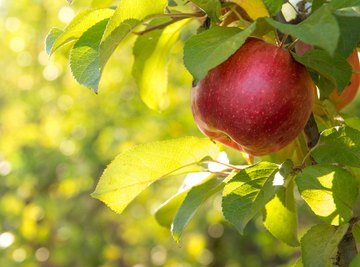
Apple trees, members of the genus Malus , are often inconspicuous during the times of year when they are not decked out in showy flowers or covered in brightly hued ripe fruits. Additionally, many wild or unpruned apple trees flower and fruit on two-year cycles, so they show none of the easily identifiable signs of being this widely loved fruit tree. Though there are roughly 7,500 varieties of apple in cultivation today, not to mention all the wild and ornamental species, most share some basic characteristics in their leaves.
So, when the springtime flowers have fallen, the fruits have not yet formed or a tree is storing up energy for the next year, it is still possible to identify an apple tree by taking a close look at the characteristics of the leaves.
Identifying Trees With a Dichotomous Key
A dichotomous key is a resource that is used to easily identify trees. It involves a series of yes or no propositions that eventually narrow down the kind of tree you are looking at. Typically, it begins with the broadest question: coniferous, or deciduous? Does the tree have narrow needles, or broad leaves?
A dichotomous key that is geared towards your local area is a fantastic resource to have in general, and it provides an excellent framework for describing the characteristics of apple leaves. Characteristics used to identify tree leaves in such a resource include: arrangement, form, margin, shape, base and apex.
Apple Leaf Arrangement and Form
Arrangement refers to the way in which leaves are ordered on the branch. If you take a branch and lay it flat, looking at the leaves on the right and left of the branch, you can see if they are symmetrical or alternate. Symmetrical leaves are like mirror images of each other on the branch. Alternate leaves, on the other hand, are not symmetrical, with each progressive leaf alternating between left and right or right and left until the end of the branch. Apple tree leaves are alternate.
Form refers to to complexity of the leaf, which can be simple, compound or twice compound. A simple leaf has a single leaf on a single stem. A compound leaf has multiple leaves on a single stem. A twice compound leaf has multiple stems and multiple leaves. With this in mind, an apple tree has a simple leaf, meaning there is a single leaf structure on one stem.
Apple Leaf Margin and Shape
The margin of leaves can be entire, or smooth; toothed, or serrated like a bread knife; or lobed, also called wavy. There are other more specific categories like serrate, double serrate and crenate, but suffice it to say apple leaves are finely toothed around the margin.
There are dozens of words that can be used to describe the shape of leaves, like acicular, or narrow and pointed; orbicular, or round; and falcate, which means sickle-shaped. Apple leaves are ovate, or egg-shaped, which means they're wider at the base.
Apple Leaf Base and Apex
The base of the leaf is the place where the broad leaf tissues meet the stem. The shape of this can be oblique, or tilted to one side; rounded, which means evenly round; or square, which means jutting out at 90 degrees. A typical apple leaf has a rounded base.
Opposite the base is the apex, the very end of the leaf. Leaves can be blunt, sharp or truncate, which means they branch in different directions. Most apple leaves will come to a point, and are therefore sharp at the apex.
Other Characteristics
The characteristics listed above are a great place to start, but there are other things to look for to identify apple leaves, such as color and texture. A number of ornamental apple cultivars have darker purple pigments in their leaves, called anthocyanins. These cultivars will have bronze or purple leaves that are hard to miss. Additionally, many apples have a "downy" appearance to their leaves, which distinguishes them from related trees like pears.
There are many ways to identify trees, but doing so solely on leaves is a good exercise in thinking like a botanist.
References
About the Author
Lynsey is a science writer, specializing in agriculture, horticulture and sustainability topics. She has an undergraduate degree in Anthropology and is working on a Master's in Science Communication.
